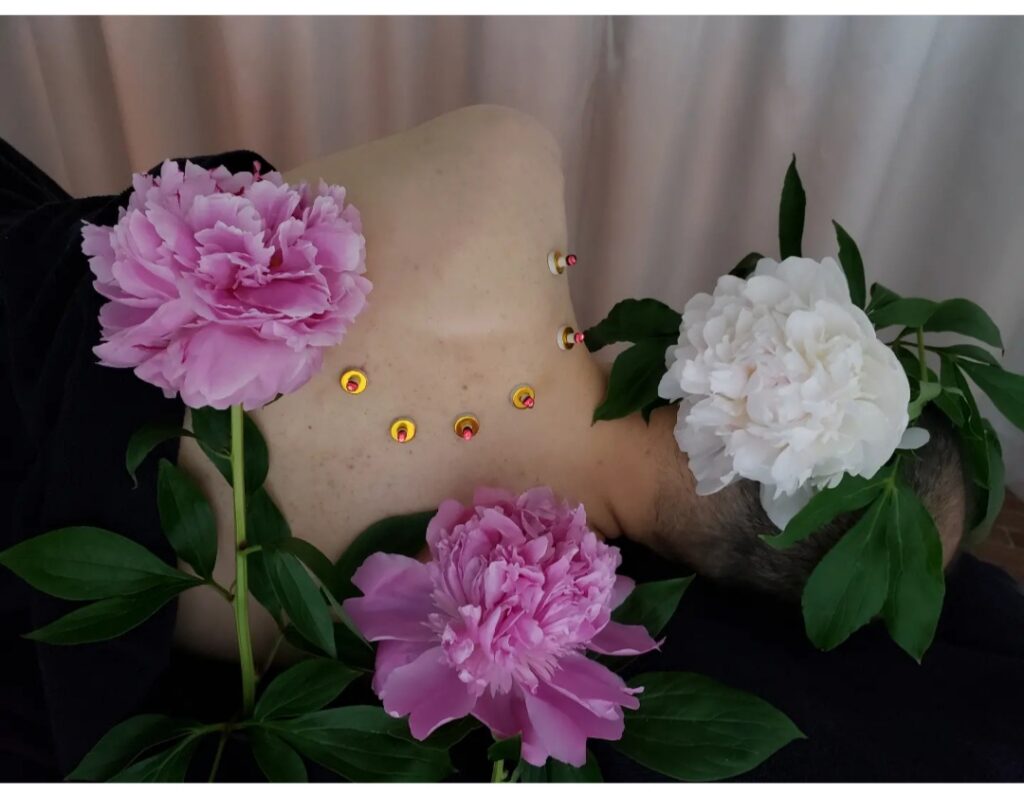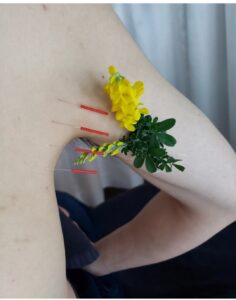肩甲骨の中が痛い
Scapula, pain.
私たちの体の中には、皮膚や筋肉を包みこんでつなぐ繊維状の組織が張り巡らされています。繊維状の組織はミカンの皮と実の間にある白い筋のようなものです。例えば、膝を曲げるとき、皮膚や筋肉、神経がぴったりくっついていると、それらが引っ張られて疼痛が生じます。ところが、繊維状の組織があれば、私たちは膝をスムーズに動かすことができます。しかし、その繊維状の組織ですが、運動不足や長時間同じ姿勢が続くと、周囲の骨や筋肉と癒着したり、浮腫を引き起こしたりして、固まってしまうのです。その結果、体を動かしづらくなり、姿勢の崩れや、肩こり、首こり、肩甲骨間のこりといった、体の不調を招きます。巷でいう、肩甲骨はがしとは、固まってしまった肩甲骨周りの筋肉と繊維状の組織をほぐしていくことを意味しています。菱形筋や肩甲挙筋など、肩こりの原因となる筋肉は、肩甲骨につながっています。本来、肩甲骨は肋骨の背中側の上にあり、島のように浮いた骨で、肋骨の上をすべるように動くようにできています。しかし、長時間じっとしていたり、スマホなどで前傾姿勢を続けることが多いと、肩甲骨が外側に広がったままで動かないため、肩甲骨周辺の筋肉の血行が悪くなって、硬くなり、ガチガチに、こりかたまっていくという悪循環になります。特に、肩甲骨を上に引き上げる役割をする肩甲挙筋と、肩甲骨を寄せる菱形筋が、肩こりと深く関連があるため、この2つの筋に痛みやコリをおこします。これらの筋肉をほぐし、肩甲骨の動きを良くすることが、肩こり解消につながります。また、肩こりの原因のなかに頭の重さがあります。頭は、体の10%で、体重50kgの人なら5kgほどになります。さらに、頭を30度ほど前かがみにするだけで、首に加わる重さはその3倍になると言われています。長時間頭を傾けていれば、首の筋肉はさらに緊張して硬くなり、血行不良や痛み、こりなどを誘発します。この首を支え、土台となっているのが肩甲骨です。鍼灸治療では、首の周りの硬くなった筋肉をほぐしてあげることで、血流を良くし、肩甲骨周囲の不調を改善していきます。また、ストレスも肩こりの原因の一つになります。ストレスを感じると筋肉や、皮膚や筋肉を包みこんでつなぐ繊維状の組織までも緊張状態になり、血流が悪くなり、自律神経にまで影響がでます。鍼灸治療は、自律神経の調整を得意としています。緊張状態になった筋肉をやわらげるだけでなく、頚椎、脊椎に通っている自律神経に働きかけ、肩甲骨周りをスッキリさせます。肩甲骨が凝り固まっているということは、全身の筋肉や関節の動きが悪くなっていて、柔軟性がなく動きに制限がある状態になるので、日常のちょっとした動作でも、ケガをしやすくなるといえます。
Our bodies are lined with fibrous tissue that wraps around and connects our skin and muscles. Fibrous tissue is like the white streaks between the skin and the fruit of a tangerine. For example, when we bend our knees, if the skin, muscles, and nerves are tightly attached, they will pull together and cause pain. With fibrous tissue, however, we can move our knee smoothly. However, if the fibrous tissue is not exercised enough or if we stay in the same position for a long period of time, it can become hardened and adhere to the surrounding bones and muscles, causing edema. As a result, it becomes difficult to move the body, leading to postural problems, stiff shoulders, stiff neck, stiffness between the shoulder blades, and other physical discomforts. The term "scapular peeling" is used to describe the process of loosening the muscles and fibrous tissue around the shoulder blades that have become tight. Muscles that cause stiff shoulders, such as the rhomboids and levator scapulae, are connected to the shoulder blades. Essentially, the scapula is an island-like floating bone that sits on top of the back side of the ribs and is designed to glide over the ribs. However, when we sit still for long periods of time or lean forward on our phones or other devices, the shoulder blades remain spread outward and do not move, resulting in a vicious cycle of poor blood circulation, stiffness, and stiffness in the muscles around the shoulder blades. In particular, the levator scapulae muscles, which pull the shoulder blades upward, and the rhomboids, which pull the shoulder blades together, are deeply related to shoulder stiffness, causing pain and stiffness in these two muscles. Relaxing these muscles and improving the movement of the shoulder blades will help relieve stiffness in the shoulders. Another cause of stiff shoulders is the weight of the head. The head is 10% of the body, which is about 5 kg for a person weighing 50 kg. Furthermore, it is said that the weight on the neck is tripled when the head is tilted forward 30 degrees. If the head is tilted for long periods of time, the neck muscles become even more tense and stiff, causing poor circulation, pain, and stiffness. The shoulder blades support and serve as the foundation of the neck. Acupuncture treatment improves blood flow and improves disorders around the shoulder blade by relaxing the stiffened muscles around the neck. Stress is another cause of stiff shoulders. Stress causes tension in the muscles and even the fibrous tissue that wraps and connects the skin and muscles, resulting in poor blood flow and affecting the autonomic nervous system. Acupuncture is good at adjusting the autonomic nervous system. Acupuncture not only softens tense muscles, but also works on the autonomic nerves that pass through the cervical vertebrae and spine to clear the area around the shoulder blades. A stiff shoulder blade means that the muscles and joints throughout the body have poor mobility and are inflexible and restricted in movement, making it easier to injure yourself, even with minor daily movements.

こ


